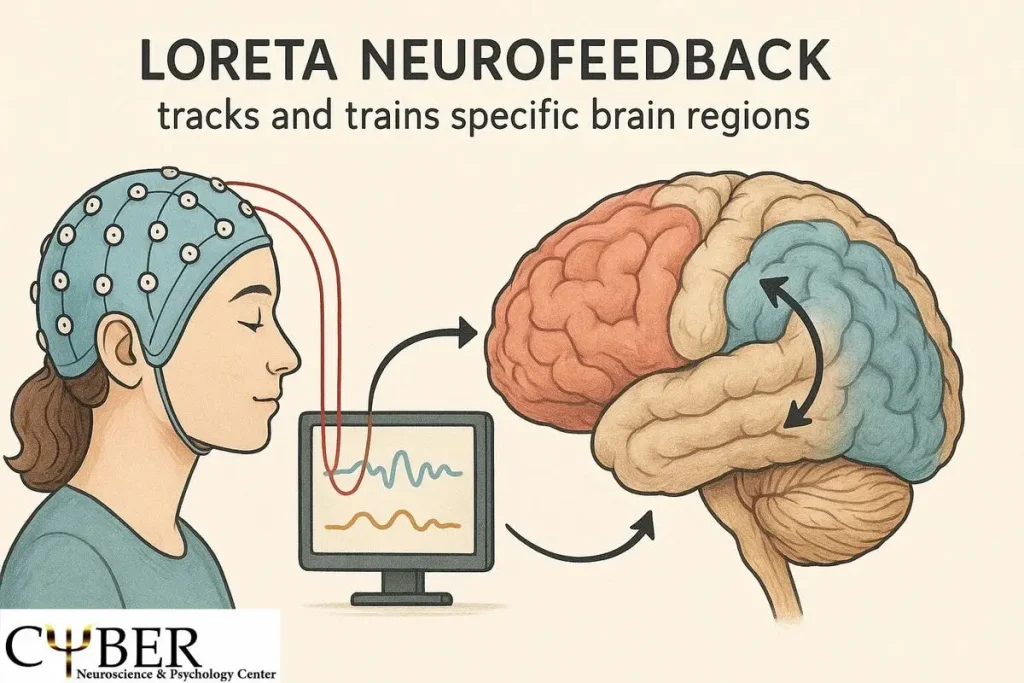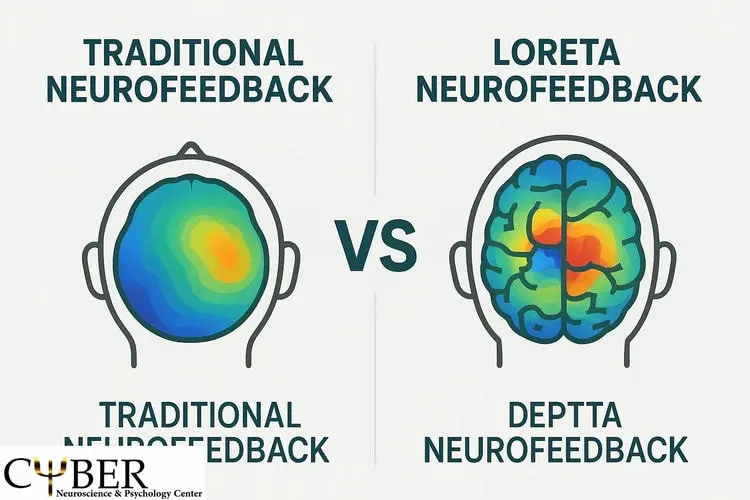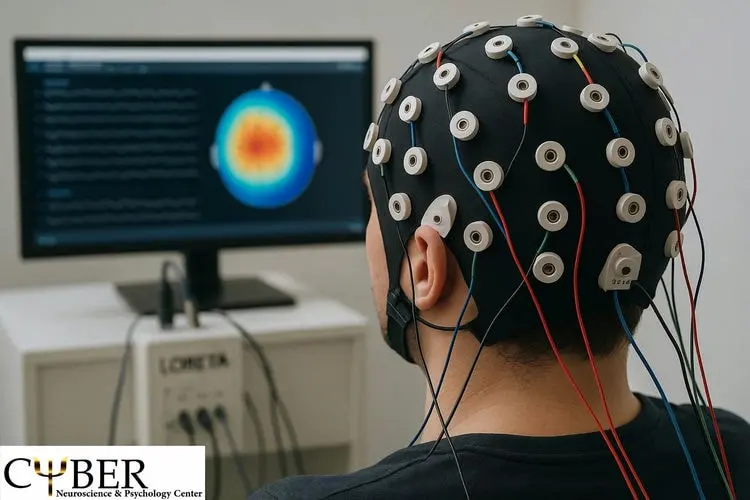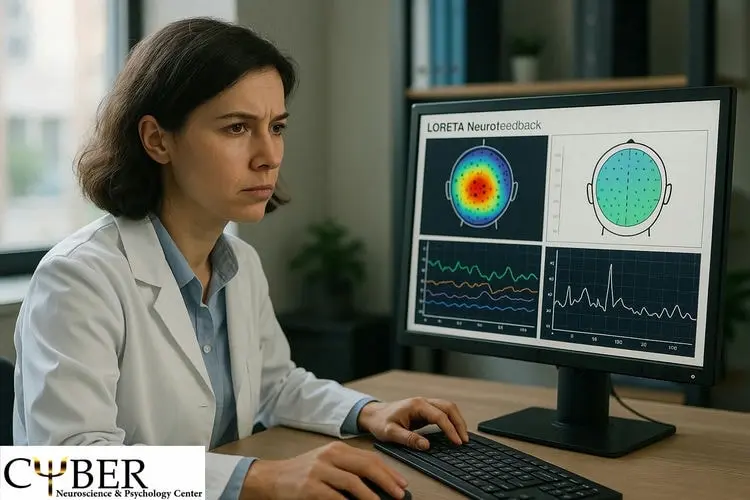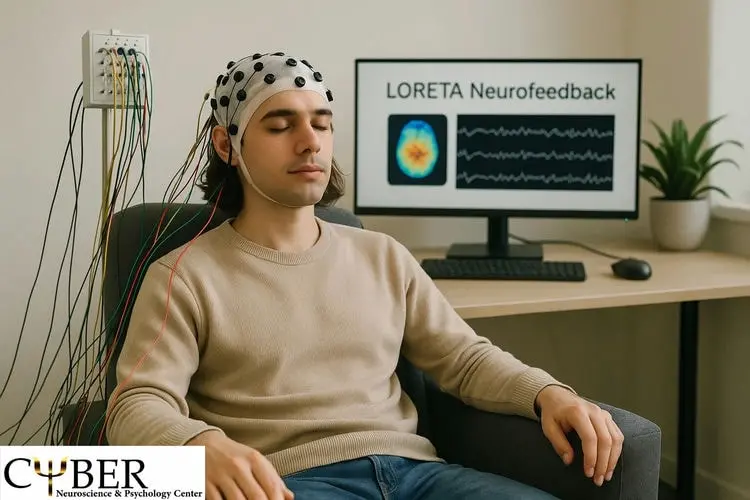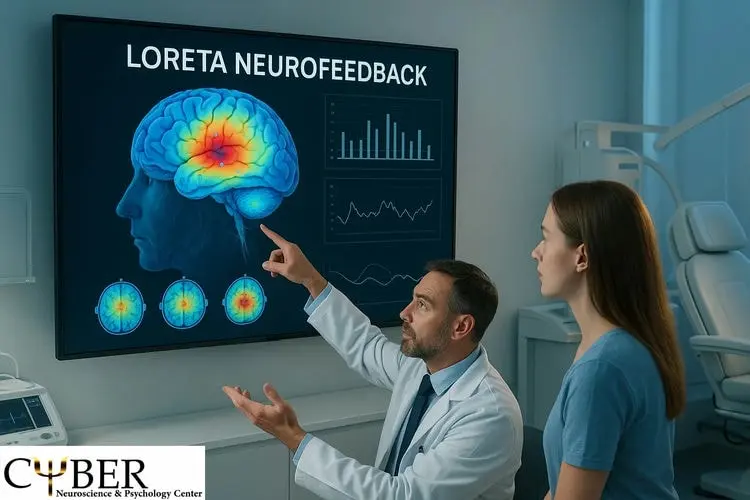What is LORETA Neurofeedback?
LORETA Neurofeedback is a cutting-edge neurotherapy technique that utilizes advanced brain imaging technology to provide real-time feedback on electrical activity deep within the brain. The acronym LORETA stands for Low-Resolution Electromagnetic Tomography, a method that maps three-dimensional neural activity beyond the brain’s surface.
This approach allows clinicians to identify and focus on specific brain regions responsible for crucial functions such as attention, emotion regulation, memory, and executive control. By targeting these areas directly, LORETA Neurofeedback helps patients improve brain function through self-regulation training.
The therapy works by monitoring brainwave patterns in targeted regions and providing patients with visual or auditory cues that encourage the brain to optimize its activity. Over time, this promotes lasting changes in neural networks, contributing to improved mental clarity, emotional balance, and cognitive performance.
LORETA Neurofeedback is non-invasive, drug-free, and highly personalized, making it a promising option for individuals dealing with various neurological and psychological conditions, including ADHD, anxiety, depression, and sleep disorders.
Difference Between Loreta Neurofeedback and Traditional Neurofeedback
While both Loreta Neurofeedback and traditional neurofeedback aim to improve brain function through feedback-based training, they differ significantly in their technology, precision, and therapeutic impact.
Traditional neurofeedback relies on surface EEG electrodes that measure electrical activity from the outer cortex of the brain. It provides feedback based on these surface signals, which can help regulate general brainwave patterns associated with attention, relaxation, or arousal. However, this method is limited in its ability to access deeper brain structures that play vital roles in complex cognitive and emotional processes.
Loreta Neurofeedback advances beyond this by employing three-dimensional electromagnetic tomography to map brain activity in deeper regions, such as the limbic system, basal ganglia, and prefrontal cortex. This precise localization enables therapists to tailor treatments that target the root causes of neurological dysregulation rather than just surface symptoms.
Key advantages of Loreta over traditional neurofeedback include:
- Deeper Brain Targeting: Access to subcortical and limbic areas that are typically unreachable with traditional methods.
- Higher Precision: Three-dimensional mapping allows for personalized protocols based on individual brain activity.
- Improved Effectiveness: Addressing deeper dysfunction often results in longer-lasting and more comprehensive improvements.
- Customizable Treatment Plans: Based on quantitative EEG (QEEG) brain mapping, therapies are fine-tuned for each patient’s unique neural profile.
Overall, Loreta Neurofeedback represents a significant evolution in neurotherapy, offering more detailed insights and effective interventions for complex brain disorders.
Can Loreta Neurofeedback Be Used to Treat Children’s Disorders?
Loreta Neurofeedback has emerged as a promising and safe therapeutic option for treating various neurological and psychological disorders in children. Unlike traditional treatments that often rely on medication, Loreta Neurofeedback offers a non-invasive and drug-free approach by directly targeting brain activity to promote self-regulation and balance.
Benefits of Loreta Neurofeedback: Why Do Patients Prefer It Over Traditional Medications?
Loreta Neurofeedback has gained significant popularity among patients seeking effective, non-invasive treatments for various neurological and psychological conditions. Many prefer this innovative therapy over traditional medications for several compelling reasons:
- Addresses the Root Cause, Not Just Symptoms
Unlike medications that primarily manage symptoms temporarily, Loreta Neurofeedback targets the brain’s underlying electrical activity to restore healthy function. This approach promotes lasting changes in brain networks, resulting in more sustainable improvements. - No Side Effects or Risk of Dependency
Traditional medications for conditions like ADHD, anxiety, or depression often come with side effects such as insomnia, appetite changes, mood swings, or risk of dependence. Loreta Neurofeedback, on the other hand, is drug-free and non-invasive, meaning patients avoid these unwanted effects entirely. - Personalized and Precise Treatment
Using advanced 3D brain mapping technology, Loreta Neurofeedback allows therapists to pinpoint and target specific brain regions that require adjustment. This precision leads to more effective and tailored treatment plans compared to the one-size-fits-all approach of many medications. - Improves Multiple Aspects of Brain Function
Patients often experience broad benefits beyond their initial symptoms, including better focus, emotional regulation, improved sleep, and reduced anxiety. These comprehensive improvements enhance overall quality of life. - Suitable for All Ages
From children struggling with attention issues to adults facing stress or cognitive decline, Loreta Neurofeedback offers a safe option for patients of all ages, unlike some medications which may not be recommended for younger or older populations. - Long-Lasting Results
The brain learns to self-regulate during Neurofeedback sessions, resulting in lasting neurological improvements that can persist well after treatment ends. This contrasts with medications, which typically require ongoing use to maintain benefits. - No Need for Continuous Medication
Patients often prefer to avoid lifelong dependency on medication. Loreta Neurofeedback provides an alternative path to managing and even overcoming symptoms without the need for daily pills.
In summary, patients favor Loreta Neurofeedback because it is a safe, effective, and holistic therapy that empowers the brain to heal itself naturally. Its advantages over traditional medications make it an increasingly popular choice for those seeking long-term wellness.
Who Are the Ideal Candidates for Loreta Neurofeedback Treatment?
Loreta Neurofeedback is a versatile and non-invasive therapy designed to help individuals with various neurological and psychological conditions. However, certain groups tend to benefit the most from this advanced brain training technique. Understanding who the ideal candidates are can help you decide if this treatment aligns with your needs or those of a loved one.
- Individuals with Attention Deficit Hyperactivity Disorder (ADHD):
People diagnosed with ADHD often struggle with attention regulation, impulsivity, and hyperactivity. Loreta Neurofeedback targets specific brain regions involved in attention control, helping to improve focus and reduce hyperactive behaviors without the need for medication. - Patients Experiencing Anxiety and Chronic Stress:
For those battling persistent anxiety or chronic stress, Loreta Neurofeedback can help rebalance brain activity associated with emotional regulation. This results in reduced feelings of anxiety and a calmer mental state over time. - Individuals with Depression:
Loreta Neurofeedback offers a promising complementary approach to traditional depression treatments by enhancing neural pathways involved in mood stabilization, potentially improving overall emotional well-being. - People Seeking Cognitive Enhancement:
Not limited to clinical conditions, Loreta Neurofeedback is also sought by students, professionals, and creatives who wish to boost memory, concentration, and mental clarity. - Patients with Sleep Disorders:
Those suffering from insomnia or poor sleep quality can benefit from Loreta Neurofeedback’s ability to regulate brainwave patterns linked to restful sleep, aiding in achieving deeper and more restorative rest. - Individuals with Panic and Stress-Related Disorders:
People experiencing panic attacks or post-traumatic stress disorder (PTSD) often find relief through Loreta Neurofeedback by promoting healthier brain responses to stress triggers. - Migraine Sufferers:
Patients with chronic migraines may experience fewer and less severe attacks, as this therapy helps regulate abnormal neural activity that contributes to migraine episodes. - People with Autism Spectrum Disorder (ASD):
In some cases, Loreta Neurofeedback supports improvements in social interaction and sensory processing in individuals on the autism spectrum by targeting relevant brain areas.
How Are Loreta Neurofeedback Therapy Sessions Conducted?
Loreta Neurofeedback therapy sessions are designed to be comfortable, non-invasive, and personalized to each patient’s unique brain activity patterns. Here’s a step-by-step overview of what typically happens during a session:
- Initial Brain Mapping (QEEG Assessment)
Before starting treatment, a quantitative electroencephalogram (QEEG) brain map is performed. This involves placing small, painless electrodes on the scalp to record electrical activity across various brain regions. The data collected helps create a detailed 3D map of brain function using the Loreta technique, identifying areas of imbalance or dysregulation. - Personalized Treatment Plan
Based on the brain map results, therapists develop a customized training protocol targeting the specific regions that require adjustment. This tailored approach enhances treatment effectiveness and focuses on the patient’s individual needs. - Preparing for the Session
During each session, the patient is comfortably seated or reclined in a quiet environment. Electrodes are gently attached to the scalp in precise locations to continuously monitor real-time brain activity. - Real-Time Feedback Through Visual and Auditory Cues
The core of Loreta Neurofeedback is providing the brain with immediate feedback. Patients view screens displaying visual patterns or animations that respond to their brain’s activity. Additionally, soothing sounds or tones may accompany the visuals. When the brain produces the desired activity patterns, positive feedback is given, encouraging the brain to maintain these healthy states. - Active Brain Training
Through this interactive process, the brain “learns” to self-regulate by reinforcing beneficial activity and reducing dysfunctional patterns. This learning occurs naturally and unconsciously, similar to how one acquires new skills. - Session Duration and Frequency
Sessions usually last between 30 to 60 minutes and are typically scheduled multiple times per week initially. The total number of sessions varies depending on the individual’s condition and response but generally ranges from 20 to 40 sessions. - Continuous Monitoring and Adjustments
Progress is regularly evaluated by reviewing brain activity data and patient feedback. Therapists adjust protocols as needed to optimize results and ensure steady improvement. - Comfort and Safety
Throughout the sessions, patients experience no pain or discomfort. The procedure is entirely non-invasive, requiring no medications or surgical intervention, making it suitable for all ages.
By combining advanced technology with personalized care, Loreta Neurofeedback therapy sessions offer a safe and effective way to promote brain health and address neurological imbalances.
Is Loreta Neurofeedback Safe for Long-Term Use?
One of the most common questions about Loreta Neurofeedback therapy concerns its safety, especially when used over an extended period. The good news is that Loreta Neurofeedback is considered one of the safest brain training methods available today, with a strong track record of long-term safety and effectiveness.
Unlike pharmacological treatments that may cause side effects such as fatigue, mood swings, or dependency, Loreta Neurofeedback works by naturally encouraging the brain to self-regulate its activity. This non-invasive approach does not involve drugs, surgery, or electrical shocks, making it a gentle and patient-friendly option suitable for both children and adults.
Clinical studies and real-world applications have shown that long-term use of Loreta Neurofeedback does not result in any harmful or lasting side effects. Instead, patients often report lasting improvements in attention, mood stability, sleep quality, and overall cognitive function even months after completing their treatment sessions.
To ensure optimal safety, Loreta Neurofeedback therapy is always administered under the guidance of trained and licensed professionals. These experts create personalized treatment plans based on detailed brain mapping (QEEG), continuously monitoring the patient’s progress and adjusting protocols as needed.
It is important to note that, while Loreta Neurofeedback is safe, results depend on commitment and adherence to the therapy schedule. Periodic follow-up sessions may be recommended to maintain and reinforce the brain’s new healthy patterns over time.
In summary, Loreta Neurofeedback stands out as a safe and effective long-term treatment option, offering sustainable brain health benefits without the risks commonly associated with medication or invasive procedures.
What Are the Expected Results from Loreta Neurofeedback Sessions?
Patients undergoing Loreta Neurofeedback therapy often experience a range of positive changes, although the speed and extent of improvement can vary depending on individual factors such as condition severity, consistency of sessions, and personal brain responsiveness. Here are some common and expected outcomes:
- Gradual and Sustainable Improvement
Unlike quick fixes, Loreta Neurofeedback promotes gradual changes by training the brain to regulate itself better. Over multiple sessions, patients typically notice enhanced concentration, reduced distractibility, and improved mental clarity that lasts beyond the treatment period. - Reduction in Anxiety and Stress Levels
Many individuals report a significant decrease in anxiety and chronic stress symptoms. The therapy helps rebalance brainwave activity linked to emotional regulation, resulting in a calmer, more relaxed mental state. - Better Sleep Quality
Improved regulation of brain activity often leads to deeper, more restful sleep. Patients frequently experience fewer sleep disturbances and enhanced overall sleep patterns, which contribute to better physical and mental health. - Enhanced Emotional Control and Self-Discipline
By optimizing neural networks involved in impulse control and emotional processing, Loreta Neurofeedback can help patients manage mood swings, impulsivity, and reactive behaviors more effectively. - Improvement in Academic and Professional Performance
Enhanced focus, memory, and executive function frequently translate into better performance at school, work, or daily tasks. Patients often find themselves more productive and capable of managing responsibilities with greater ease. - Personalized Results Based on Individual Needs
Because the treatment targets specific brain regions based on the patient’s unique brain map, results are tailored and highly relevant to their particular challenges, whether related to ADHD, anxiety, migraines, or other neurological conditions. - Long-Term Benefits with Maintenance
The skills the brain learns during therapy are retained over time. While some patients benefit from occasional “booster” sessions to maintain improvements, many experience lasting positive changes without ongoing treatment.
It’s important to remember that while Loreta Neurofeedback offers promising results, the effectiveness depends on regular attendance, commitment to the treatment plan, and collaboration with trained professionals who can fine-tune the therapy as needed.
How to Maintain the Long-Term Results of Loreta Neurofeedback Treatment?
Achieving positive changes through Loreta Neurofeedback is a significant step toward improved brain function and overall well-being. However, maintaining these benefits over the long term requires ongoing care and certain lifestyle habits. Here are key strategies to help preserve and even enhance the results of your treatment:
- Commit to Regular Follow-Up Sessions:
After completing the initial treatment plan, scheduling periodic booster sessions can help reinforce the brain’s improved regulation. These follow-ups prevent relapse and support sustained neural balance. - Practice Mindfulness and Relaxation Techniques:
Incorporating activities like meditation, deep breathing exercises, and yoga can strengthen the brain’s ability to manage stress and maintain emotional stability, complementing the effects of neurofeedback. - Maintain a Healthy Lifestyle:
A balanced diet rich in nutrients, consistent physical exercise, and sufficient sleep play a crucial role in supporting optimal brain function. These habits help sustain the neural improvements gained through therapy. - Stay Engaged in Cognitive Activities:
Challenging your brain through puzzles, reading, learning new skills, or engaging in creative hobbies can promote neuroplasticity and further enhance cognitive abilities. - Monitor and Manage Stress Levels:
Identifying stress triggers and employing effective coping strategies help prevent excessive strain on the brain, preserving the therapeutic gains of Loreta Neurofeedback. - Maintain Open Communication with Your Healthcare Provider:
Regular check-ins with your neurofeedback specialist or healthcare team ensure that your treatment plan remains tailored to your evolving needs. Adjustments can be made based on your progress or any new challenges.
By following these guidelines, individuals can maximize the longevity of their Loreta Neurofeedback treatment outcomes, enjoying a healthier, more balanced mental state for years to come.
Frequently Asked Questions About Loreta Neurofeedback Treatment
Is it painful or uncomfortable?
No, Loreta Neurofeedback is a non-invasive and painless therapy. During sessions, patients sit or lie comfortably while sensors are gently placed on the scalp. There are no surgical procedures or medications involved, making it safe and well-tolerated.
How many sessions are typically required?
The number of sessions varies depending on the individual’s condition and severity of symptoms. Generally, patients undergo between 20 to 40 sessions spread over several weeks or months for optimal results.
Can children undergo Loreta Neurofeedback therapy?
Yes, Loreta Neurofeedback is safe and effective for both children and adults. It is especially recommended for children with conditions like ADHD, anxiety, and sleep disorders as a non-medication treatment option.
How soon can results be noticed?
Some patients experience minor improvements after the first few sessions, but significant and lasting benefits usually develop gradually with ongoing therapy.
Are there any side effects of Loreta Neurofeedback?
Loreta Neurofeedback has no known serious side effects. Unlike medication, it does not involve chemicals or drugs, making it a very safe alternative therapy.
Is it suitable for everyone?
While highly effective for many neurological and psychological conditions, it is important that treatment be supervised by qualified professionals who tailor therapy to each individual’s brain activity.
Can Loreta Neurofeedback replace medication?
Loreta Neurofeedback can be an effective complementary or alternative treatment. However, decisions about medication use should always be made with a healthcare provider.
Conclusion
Loreta Neurofeedback represents a significant advancement in brain therapy, offering a precise, non-invasive, and drug-free approach to improving brain function. By targeting deep brain regions responsible for attention, mood, and behavior, this innovative technique addresses the root causes of many neurological and psychological conditions.
Compared to traditional neurofeedback and medication, Loreta provides a more personalized and effective treatment option, with fewer side effects and longer-lasting benefits. Whether you are struggling with ADHD, anxiety, depression, migraines, or other brain-related challenges, Loreta Neurofeedback offers hope for meaningful and sustainable improvement.
At specialized centers like CyberNeuro in Muscat, Oman, patients receive expert care supported by the latest technology and clinical research. If you’re considering brain therapy, Loreta Neurofeedback is a promising path worth exploring.
Follow us on Instagram for more information:
